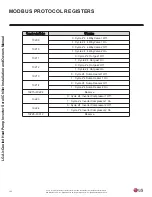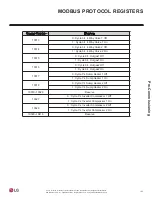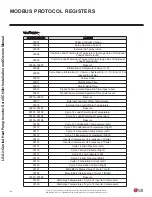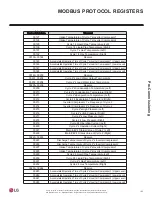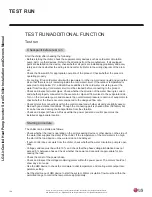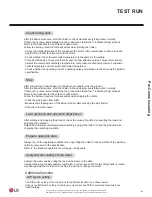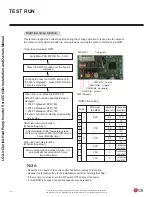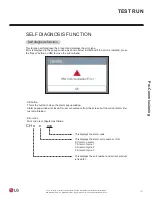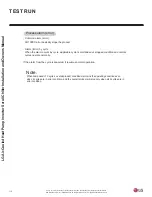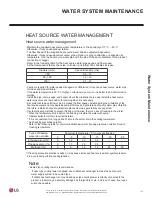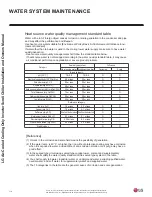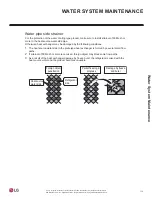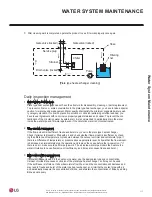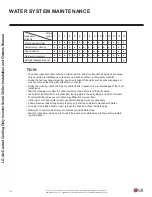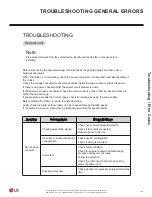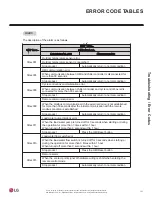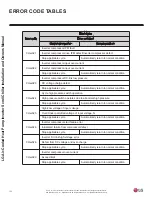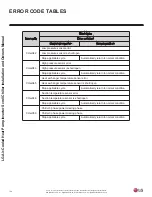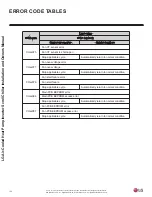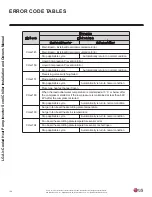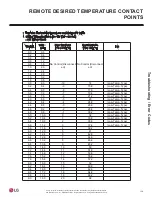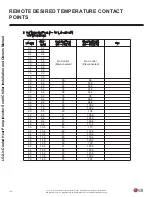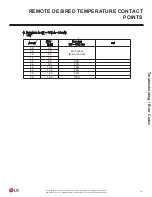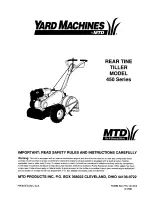
116
Due to our policy of continuous product innovation, some specifications may change without notification.
©LG Electronics U.S.A., Inc., Englewood Cliffs, NJ. All rights reserved. “LG” is a registered trademark of LG Corp.
LG
Air-Cooled Cooling Only Inverter Scroll Chiller Installation and Owners Manual
WATER SYSTEM MAINTENANCE
Plate type heat exchanger maintenance
As scale generation is accumulated, plate type heat exchanger efficiency may be decreased or damage
may occur by freeze and burst with decreased flow amount.
For such reasons, it is necessary to have periodical management to prevent scale generation.
1
Before entering the usage season, check the following items. (Period: 1 time per year)
1) Perform water quality inspection to see if it is within the standard condition.
2) Perform strainer cleaning.
3) Check if the flow amount is adequate.
4) Check if operation environment is adequate. (Pressure, flow amount, water outlet temperature, etc.)
2
To clean the plate type heat exchanger, follow the procedures below. (Period: 1 time per year)
1) Check if service port is mounted on the water pipe for chemical solvent cleaning.
5% diluted formic acid, citric acid, oxalic acid(water acid), acetic acid, phosphoric acid, etc. are suit-
able as the chemical solvent for scale cleaning. (* Hydrochloric acid, sulfuric acid, nitric acid, etc.
have corrosive property, so they may never be used.)
2) During the cleaning, make sure if water inlet and outlet pipe gate valve and drain pipe valve are
properly locked.
3) Connect the pipe for chemical solvent cleaning through water pipe service plug, fill the cleaning sol-
vent of about 50 °C ~ 60 °C in the plate type heat exchanger, and circulate with pump for about 2 ~
5 hours. The circulation time may be different according to the cleaning solvent temperature or
amount of scale. Therefore, closely observe the chemical solvent color changes to decide the circu-
lation time for scale removal.
4) After the solvent circulation work, completely drain the chemical solvent in the plate type heat
exchanger, fill 1~2 % concentration sodium hydroxide (NaOH) or hydrocarbon sodium (NaHCO
3
) and
circulate for about, 15~20 min. to neutralize the heat exchanger.
5) After the neutralization work is completed, clean inside the plate type heat exchanger with clean
water. By measuring the pH concentration of the water, you can verify if the chemical solvent is
properly removed.
6) If you use other type of chemical solvent in the market, make sure to check if there is any corrosive
property against stainless or copper in advance.
7) Receive consultation from the experts in the relevant industry for details of cleaning chemical sol-
vent.
n
o
it
c
A
d
n
a
n
o
it
c
e
p
s
n
I
e
s
u
a
C
s
u
t
a
t
S
y
r
o
g
e
t
a
C
Whether
heat
source
water is
supplied
CH 13
It is the error detected with
regards to the heat source
water during the flow
switch connection, and heat
source water does not flow,
or flow amount is insuffi-
cient.
(All operation conditions)
Check if heat source water supply pump works.
Check blocking of the heat source water pipe. (Strainer
cleaning, valve locked, valve problem,
air in the pipe, etc.)
Check flow switch problem. (Flow switch disorder,
unauthorized handling, disconnection, etc.)
CH 180
Heat source water does not
flow, or flow amount is
insufficient.
Check if heat source water supply pump works
Check blocking of the heat source water pipe. (Strainer
cleaning, valve locked, valve problem,
air in the pipe, etc.)
Actions for problems in the test operation

